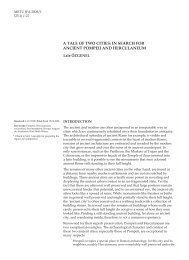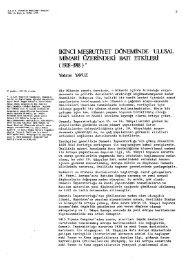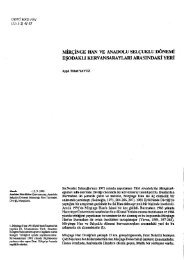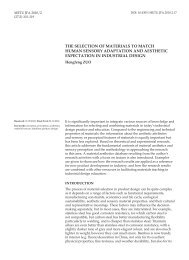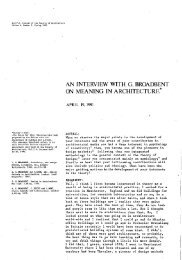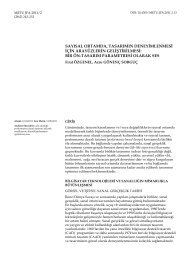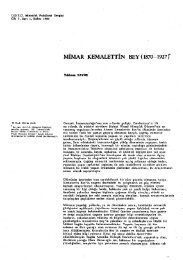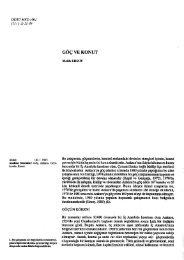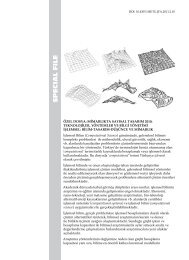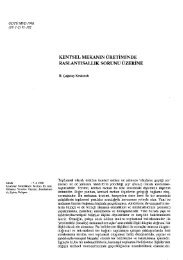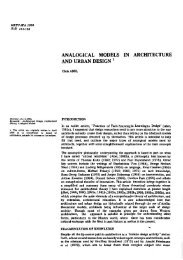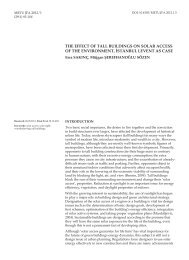INTERVIEW v METU JFA 2006/1 - Journal of the Faculty of ...
INTERVIEW v METU JFA 2006/1 - Journal of the Faculty of ...
INTERVIEW v METU JFA 2006/1 - Journal of the Faculty of ...
Create successful ePaper yourself
Turn your PDF publications into a flip-book with our unique Google optimized e-Paper software.
<strong>INTERVIEW</strong> <strong>METU</strong> <strong>JFA</strong> <strong>2006</strong>/1 v<br />
1. Realized on electronic mail, 26-28 March; 7<br />
April and 14-15 April <strong>2006</strong>; I owe special<br />
thanks to Gamze Ege and Sanem Güvenç-<br />
Salgýrlý for <strong>the</strong>ir suggestions.<br />
2. Anthony D. King, Colonial Urban<br />
Development: Culture, Social Power and<br />
Environment (1976), Urbanism, Colonialism<br />
and <strong>the</strong> World-Economy: Cultural and<br />
Spatial Foundations <strong>of</strong> <strong>the</strong> World Urban<br />
System (1990), The Bungalow: The<br />
Production <strong>of</strong> a Global Culture (1995), Spaces<br />
<strong>of</strong> Global Cultures: Architecture, Urbanism,<br />
Identity (2004).<br />
top right: Marketing Tradition: The Dutch<br />
Pavilion, Paris 1931; p. 27.<br />
ABIDIN KUSNO<br />
BEHIND THE POSTCOLONIAL:<br />
ARCHITECTURE, URBAN SPACE AND<br />
POLITICAL CULTURES IN INDONESIA<br />
(London and New York: Routledge, Taylor&<br />
Francis) 2000, xiv+250pp.<br />
ISBN: 0-415-23615-0<br />
AN <strong>INTERVIEW</strong> WITH ABIDIN KUSNO<br />
on “BBeehhiinndd tthhee PPoossttccoolloonniiaall:: AArrcchhiitteeccttuurree,, UUrrbbaann SSppaaccee aanndd PPoolliittiiccaall CCuullttuurreess iinn<br />
IInnddoonneessiiaa” (Routledge, 2000) and “AAppppeeaarraanncceess o<strong>of</strong>f MMeemmoorryy:: AArrcchhiitteeccttuurree,, SSppaattiiaall<br />
PPoolliittiiccss aanndd tthhee MMaakkiinngg o<strong>of</strong>f NNeeww TTiimmeess” (Unpublished book manuscript).<br />
Introductory Remarks<br />
Abidin Kusno is Associate Pr<strong>of</strong>essor<br />
and Canada Research Chair in Asian<br />
Urbanism and Culture at University <strong>of</strong><br />
British Columbia (1). Kusno’s work can<br />
be situated within an emerging tradition<br />
<strong>of</strong> writings on colonial and postcolonial<br />
architecture and urbanism, following<br />
<strong>the</strong> path opened by Anthony D. King’s<br />
groundbreaking book, Colonial Urban<br />
Development (1976), as well as his<br />
subsequent and most recent<br />
contributions (2). Behind <strong>the</strong><br />
Postcolonial, along with o<strong>the</strong>r recent<br />
publications from <strong>the</strong> discipline <strong>of</strong><br />
architecture, constitutes an emerging<br />
scholarship critical <strong>of</strong> <strong>the</strong> mainstream<br />
architectural historiography (3).<br />
Kusno’s work on colonial and<br />
postcolonial Indonesia addresses broad<br />
<strong>the</strong>mes through specific contemporary<br />
and historical cases and speaks to <strong>the</strong><br />
Indonesian audience as much as it does<br />
to readers in o<strong>the</strong>r places experiencing<br />
(problematically) a condition <strong>of</strong><br />
postcoloniality. Turkish readers will<br />
find in his political history <strong>of</strong><br />
architecture and urbanism in Indonesia<br />
a narrative that engages with both local<br />
politics and transnational power<br />
relations. Moving in and out specific<br />
contexts and asking broad questions in<br />
relation to colonialism, modernity and<br />
nationalism, Kusno’s work on<br />
postcoloniality <strong>of</strong>fers a particular way <strong>of</strong><br />
thinking about o<strong>the</strong>r places.<br />
Although Turkey’s relation to “colonial<br />
history” and <strong>the</strong>“postcolonial<br />
condition” is ra<strong>the</strong>r ambiguous, <strong>the</strong><br />
body <strong>of</strong> postcolonial literature <strong>of</strong>fers<br />
new possibilities. Its <strong>the</strong>orization might<br />
allow Turkish architecture to be placed<br />
beyond <strong>the</strong> conceptual binaries <strong>of</strong><br />
“periphery” and “center” and as<br />
product <strong>of</strong> a modernity, which is shared<br />
and mutually constituted both by “<strong>the</strong><br />
western” and <strong>the</strong> “non-western” world.<br />
In this sense, <strong>the</strong>re are many parallels<br />
between recent critical works in Turkey<br />
on <strong>the</strong> history <strong>of</strong> architecture and<br />
urbanism and Kusno’s demystification<br />
<strong>of</strong> <strong>the</strong> colonizer / colonized binary in<br />
<strong>the</strong> context <strong>of</strong> Indonesian cities and<br />
o<strong>the</strong>r Asian countries (4).<br />
Thus, <strong>the</strong> following interview can be<br />
seen as an attempt to forge a critical<br />
dialogue with o<strong>the</strong>r historical contexts.<br />
It is structured loosely by issues raised
vi <strong>METU</strong> <strong>JFA</strong> <strong>2006</strong>/1<br />
3. The Modernist City: An Anthropological<br />
Critique <strong>of</strong> Brasilia (James Holston 1989), The<br />
Politics <strong>of</strong> Design in French Colonial<br />
Urbanism (Gwendolyn Wright 1991), Forms<br />
<strong>of</strong> Dominance: On <strong>the</strong> Architecture and<br />
Urbanism <strong>of</strong> <strong>the</strong> Colonial Enterprise (Nezar<br />
Al Sayyad 1992), Postcolonial Space(s)<br />
(Gülsüm Nalbantoðlu and Wong Chong Thai<br />
1997), Urban Forms and Colonial<br />
Confrontations : Algiers under French Rule<br />
(Zeynep Çelik 1997), Postcolonial Urbanism:<br />
Sou<strong>the</strong>ast Asian Cities and Global Processes<br />
(Ryan Bishop, John Phillips and Wei Wei Yeo<br />
2003), Indigenous Modernities: Negotiating<br />
Architecture, Urbanism and Colonialism<br />
(Jyoti Hosagrahar 2005), Writing Spaces:<br />
Discourses <strong>of</strong> Architecture, Urbanism, and<br />
<strong>the</strong> Built Environment, 1960-2000 (Greig<br />
Crysler 2005).<br />
4. Modernism and Nation Building: Turkish<br />
Architectural Culture in <strong>the</strong> Early Republic<br />
(Sibel Bozdoðan 2001), Modernin Saati: 20.<br />
Yüzyýlda Modernleþme ve Demokratikleþme<br />
Pratiðinde Mimarlar, Kamusal Mekan ve<br />
Konut Mimarlýðý (Ali Cengizkan 2002),<br />
Mübadele Konut ve Yerleþimleri (Ali<br />
Cengizkan 2004), Ýstanbul 1900-2000, Konutu<br />
ve Modernleþmeyi Metropolden Okumak<br />
(Uður Tanyeli 2004).<br />
5. Kusno (2000) Behind <strong>the</strong> Postcolonial:<br />
Architecture, Urban Space and Political<br />
Cultures in Indonesia, Routledge, London<br />
and New York; 212.<br />
6. Ama Ata Aidoo, quoted in Andermahr,<br />
Sonya, Terry Lovell, and Carol Wolkowitz<br />
(1997) A Concise Glossary <strong>of</strong> Feminist<br />
Theory, Arnold; London, New York; 168.<br />
7. Kusno, “Introduction.”, in Appearances <strong>of</strong><br />
Memory: Architecture, Spatial Politics and<br />
<strong>the</strong> Making <strong>of</strong> New Times (Unpublished<br />
book manuscript).<br />
‘Colonial Replica: The Institute <strong>of</strong><br />
Technology at Baudung (ITB)’, p. 82<br />
in Kusno’s Behind <strong>the</strong> Postcolonial and<br />
a collection <strong>of</strong> his current essays which<br />
will be put toge<strong>the</strong>r under a volume<br />
tentatively entitled, Appearances <strong>of</strong><br />
Memory: Architecture, Spatial Politics<br />
and <strong>the</strong> Making <strong>of</strong> New Times.”<br />
Time, Space and History: Colonialism<br />
and <strong>the</strong> Postcolonial World<br />
1. Dear Abidin Kusno. While your book<br />
Behind <strong>the</strong> Postcolonial (2000) locates<br />
architecture and urbanism within <strong>the</strong><br />
social and political contexts <strong>of</strong><br />
Indonesia, I think that it can also be put<br />
to use in addressing issues relevant to<br />
o<strong>the</strong>r places. In it, you raise significant<br />
<strong>the</strong>oretical questions central to <strong>the</strong> study<br />
<strong>of</strong> architecture <strong>of</strong> urbanism. Your<br />
arguments are rooted in and<br />
empowered by postcolonial criticism,<br />
but you simultaneously generate a<br />
different direction for thinking about<br />
issues around colonial culture and<br />
postcolonial conditions. In order to<br />
introduce <strong>the</strong> central concern <strong>of</strong> your<br />
study, allow me to start with <strong>the</strong><br />
conclusion <strong>of</strong> <strong>the</strong> book. Here, you<br />
conclude by saying that <strong>the</strong><br />
contemporary “dialogue with <strong>the</strong><br />
colonial past”, ei<strong>the</strong>r in <strong>the</strong> form <strong>of</strong><br />
forgetting or remembering, “has<br />
resulted, among o<strong>the</strong>r things, in <strong>the</strong><br />
reproduction <strong>of</strong> a form <strong>of</strong> colonialism<br />
itself” (5). In this sense, do you agree<br />
with critics <strong>of</strong> postcolonial <strong>the</strong>ory who<br />
insistently argue that “colonialism has<br />
not been ‘post’-ed anywhere”? (6)<br />
You have underlined a central concern<br />
in <strong>the</strong> book one that deals with <strong>the</strong><br />
politics, history and <strong>the</strong> representation<br />
<strong>INTERVIEW</strong><br />
<strong>of</strong> time. The book was completed at <strong>the</strong><br />
end <strong>of</strong> Suharto regime (which ruled<br />
from 1966-1998), in <strong>the</strong> midst <strong>of</strong><br />
atrocities in <strong>the</strong> major cities <strong>of</strong> Indonesia<br />
and violence against <strong>the</strong> pro-<br />
Independence East Timor. It could<br />
<strong>the</strong>refore be seen as a form <strong>of</strong> cultural<br />
intervention critical <strong>of</strong> <strong>the</strong> recent past <strong>of</strong><br />
Indonesia. It approaches <strong>the</strong><br />
postcolonial Suharto regime as if it were<br />
a regime <strong>of</strong> colonial time which<br />
underwent a crisis not only in politics<br />
and economy, but also in culture. I used<br />
architecture and urbanism to tell such<br />
story and in my story, I point to <strong>the</strong><br />
continuity between colonial time and<br />
<strong>the</strong> era after decolonization. On ano<strong>the</strong>r<br />
level, <strong>the</strong> book deals with colonial and<br />
postcolonial continuum and shows how<br />
<strong>the</strong> issues that pre-occupied architects<br />
and planners <strong>of</strong> <strong>the</strong> colonial era are also<br />
those <strong>of</strong> our own time. Issues such as<br />
au<strong>the</strong>nticity, tradition, identity,<br />
modernity, and modernization in<br />
architecture were as important back<br />
<strong>the</strong>n as <strong>the</strong>y are today in architectural<br />
debates. These are issues that seem to<br />
cut across colonial time and <strong>the</strong> era <strong>of</strong><br />
Independence.<br />
Whe<strong>the</strong>r “colonialism has not been<br />
‘post’-ed anywhere” is, I think, less a<br />
matter <strong>of</strong> fact than an intellectual<br />
position that one has to develop for<br />
matters <strong>of</strong> his or her concern. The notion<br />
<strong>of</strong> “postcolonial” (as I used it in my<br />
work) carries two contradictory<br />
consciousnesses. It indicates an<br />
awareness <strong>of</strong> a radically new era <strong>of</strong><br />
“decolonization” which <strong>of</strong>fers different<br />
constraints and opportunities. Yet, this<br />
sense <strong>of</strong> discontinuity on <strong>the</strong> part <strong>of</strong><br />
decolonized nations is also haunted by a<br />
pr<strong>of</strong>ound sense <strong>of</strong> continuity with <strong>the</strong>ir<br />
colonial past. The once-colonized<br />
countries continue to be dealing with<br />
historically situated forms <strong>of</strong><br />
representation (such as architecture and<br />
planning practices) which traverse<br />
across both <strong>the</strong> past and <strong>the</strong> present.<br />
The standard nationalist historiography<br />
overcome this contradiction by resorting<br />
to a dichotomy <strong>of</strong> colonial past and <strong>the</strong><br />
era <strong>of</strong> Independence – <strong>the</strong> former<br />
represents darkness and <strong>the</strong> later<br />
represents light. It is a story <strong>of</strong> how <strong>the</strong><br />
sense <strong>of</strong> victimhood is overcome by<br />
heroic recovery in economic<br />
development under <strong>the</strong> guidance <strong>of</strong> a<br />
patrimonial state. It is this<br />
developmentalist framework that <strong>the</strong><br />
book aims to be critical <strong>of</strong>. Instead <strong>of</strong>
<strong>INTERVIEW</strong> <strong>METU</strong> <strong>JFA</strong> <strong>2006</strong>/1 vii<br />
8. Sideway, James D. (2000) “Postcolonial<br />
Geographies: An Exploratory Essay”,<br />
Progress in Human Geography, 24/4, 2000;<br />
593, 606.<br />
9. Kusno (2000) Behind <strong>the</strong> Postcolonial; 8.<br />
10. Kusno, Appearances <strong>of</strong> Memory, Chapter<br />
2: “The Past in <strong>the</strong> Present: The Empire, <strong>the</strong><br />
Indies and <strong>the</strong> Art Deco,” (Unpublished<br />
book manuscript).<br />
showing <strong>the</strong> discontinuity <strong>of</strong> <strong>the</strong> past<br />
and <strong>the</strong> present, I try to show <strong>the</strong>ir<br />
connection, or better, <strong>the</strong> present<br />
dialogue with <strong>the</strong> colonial past which<br />
would lead us to <strong>the</strong> politics <strong>of</strong> memory,<br />
forgetting and invention.<br />
2. In Appearances <strong>of</strong> Memory you seek<br />
to problematize <strong>the</strong> relationship<br />
between memory and buildings in <strong>the</strong><br />
postcolonial world without “taking <strong>the</strong><br />
colonial past as <strong>the</strong> point <strong>of</strong> departure.”<br />
O<strong>the</strong>rwise, as you have pointed out, we<br />
are likely to “repeat <strong>the</strong> Eurocentric<br />
narrative that denies <strong>the</strong> spatial and<br />
temporal simultaneity between <strong>the</strong><br />
colonizer and <strong>the</strong> colonized in <strong>the</strong>ir<br />
mutually constitutive attempts to make<br />
sense <strong>of</strong> modernity” (7). If what is<br />
defined as “postcolonial” could be seen<br />
as ano<strong>the</strong>r form <strong>of</strong> <strong>the</strong> “colonial”, to<br />
what extent has postcolonial <strong>the</strong>ory<br />
been useful in developing <strong>the</strong> tools <strong>of</strong><br />
“decolonization”? Some have argued<br />
that this process requires <strong>the</strong><br />
dismantling <strong>of</strong> <strong>the</strong> “western<br />
(imperialist) forms <strong>of</strong> knowledge”<br />
transmitted through institutions such as<br />
geography, which evolved “as a<br />
western-colonial science” (8).<br />
The legacy <strong>of</strong> colonialism continues in<br />
various forms including <strong>the</strong> most<br />
explicit one, namely war and occupation<br />
today under various names. In this<br />
context it is important for academic<br />
disciplines (including architecture) to<br />
have a sense <strong>of</strong> geo-history and geopolitical<br />
economy <strong>of</strong> culture and to be<br />
sensitive to <strong>the</strong> ways in which<br />
knowledge could contribute to <strong>the</strong><br />
exercise <strong>of</strong> power as well as a sense <strong>of</strong><br />
injustices. We won’t be able to<br />
immediately assess how oppressive,<br />
say, colonial spatial segregation based<br />
on race had been, but that form <strong>of</strong><br />
knowledge would make us aware <strong>of</strong><br />
how a discipline such as urban design<br />
can become part <strong>of</strong> colonial practices. To<br />
“decolonize” forms <strong>of</strong> knowledge is to<br />
acknowledge, expose and thus sensitize<br />
<strong>the</strong> connection between knowledge and<br />
colonialism. On <strong>the</strong> o<strong>the</strong>r hand,<br />
“decolonizing” knowledge could also be<br />
problematic. Quite <strong>of</strong>ten, it aspires for a<br />
transcendental, if not purified,<br />
uncolonized knowledge, a position<br />
which <strong>of</strong>ten opens up even more<br />
opportunity for “colonialism” to step in.<br />
I would ra<strong>the</strong>r suggest something<br />
modest, that we recognize <strong>the</strong> legacies<br />
and presences <strong>of</strong> colonialism as a basis<br />
for thinking about decolonization. This<br />
recognition will pose a limit to <strong>the</strong><br />
imperial nature <strong>of</strong> knowledge.<br />
Appearances <strong>of</strong> Memory thus could be<br />
seen as an effort to look at <strong>the</strong><br />
“postcolonial” not only in terms <strong>of</strong> its<br />
temporal coordinate (as has normally<br />
been used), but in terms <strong>of</strong> <strong>the</strong> change<br />
in space and how <strong>the</strong> transformation <strong>of</strong><br />
spatial and built environment help<br />
shape new social and political<br />
consciousness. It is in this sense <strong>the</strong>n <strong>the</strong><br />
“postcolonial” could be seen as ano<strong>the</strong>r<br />
form <strong>of</strong> <strong>the</strong> “colonial” and similarly,<br />
during <strong>the</strong> colonial era, <strong>the</strong>re are<br />
various politics <strong>of</strong> spatial control and<br />
different attempts to achieve liberation.<br />
3. Do you think, out <strong>of</strong> your studies on<br />
postcolonial architecture and urbanism<br />
that it will ever be possible for both<br />
scholars and people in postcolonial<br />
states to “recognize colonialism without<br />
colonizing [<strong>the</strong>ir] own imagination”? (9)<br />
I think one way to “recognize<br />
colonialism without colonizing our own<br />
imagination” is to consider colonial<br />
legacy as a “gift.” In a way, Behind <strong>the</strong><br />
Postcolonial tries to make use <strong>of</strong> that<br />
gift by repackaging it for <strong>the</strong> cultural<br />
intervention <strong>of</strong> <strong>the</strong> present. In a more<br />
general sense, “recognizing colonialism<br />
without colonizing our imagination”<br />
would entail an incorporation <strong>of</strong><br />
historical and contemporary colonialism<br />
as contexts for thinking about<br />
architecture and urbanism. If, as an<br />
attempt to decolonize knowledge, we<br />
only write about our own space<br />
mobilizing only things considered as<br />
“local” and “au<strong>the</strong>ntic,” <strong>the</strong>n we would<br />
end up repeating, not only <strong>the</strong><br />
metaphysic <strong>of</strong> binarism, but also what<br />
Edward Said used to call<br />
“compartmental view” <strong>of</strong> history and<br />
culture.<br />
4. In <strong>the</strong> second chapter <strong>of</strong> Appearances<br />
<strong>of</strong> Memory, you talk about <strong>the</strong><br />
reappearance <strong>of</strong> “modernist Art-Deco”<br />
in contemporary Indonesia, which was<br />
one <strong>of</strong> <strong>the</strong> dominant colonial styles in<br />
<strong>the</strong> 1930s. In your account, Budi Lim<br />
presented modernist vocabulary as a<br />
possible route to define “Indonesian<br />
architecture” (10). Perhaps we, as<br />
architectural historians, share a common<br />
problematic with architects such as Lim,<br />
who resort to a (colonial) past to deal<br />
with issues <strong>of</strong> identity and au<strong>the</strong>nticity<br />
in <strong>the</strong> architectural present. I think we
viii <strong>METU</strong> <strong>JFA</strong> <strong>2006</strong>/1<br />
11. Nicolai, Bernd (1998) Moderne und Exil,<br />
Deutschsprachige Architekten in der Turkei<br />
1925-1955, Verlag für Bauwesen, Berlin.<br />
12. This question was raised by Bülent<br />
Batuman in a personal conversation.<br />
also need to problematize in <strong>the</strong> larger<br />
scale, how modernist art deco itself, as it<br />
has originated in <strong>the</strong> west, was shaped<br />
not independently from colonial or<br />
global relations. Similarly, it is not less<br />
meaningful to ask how “au<strong>the</strong>ntic”<br />
British, Dutch or French architecture is.<br />
But is <strong>the</strong>re an answer?<br />
There are perhaps various ways <strong>of</strong><br />
challenging <strong>the</strong> mainstream stylistic and<br />
formalist readings <strong>of</strong> architecture which<br />
have prevailed in architectural history.<br />
There are works on stylistic hybridity<br />
and syncretic form <strong>of</strong> architecture in<br />
say, British, Dutch or French<br />
architecture, but I think one should go<br />
fur<strong>the</strong>r to trace <strong>the</strong> geopolitical and<br />
historical relations within which <strong>the</strong><br />
invention <strong>of</strong> architectural traditions are<br />
embedded. Ano<strong>the</strong>r way is to go deeper<br />
by tracing <strong>the</strong> unconscious<br />
identification. This kind <strong>of</strong> tracing<br />
would assume <strong>the</strong> existence <strong>of</strong> a<br />
dimension “beneath” architecture one<br />
that supplies <strong>the</strong> reference for <strong>the</strong><br />
“rationality” <strong>of</strong> “European” architecture<br />
even as this contribution is subjected to<br />
negation.<br />
5. I would like to relate <strong>the</strong> case <strong>of</strong><br />
foreign architects who came to Turkey<br />
from German-speaking countries during<br />
<strong>the</strong> 1930s, and were commissioned by<br />
<strong>the</strong> Turkish state to design significant<br />
urban and architectural projects (11).<br />
This period has mostly been researched<br />
for <strong>the</strong> purpose <strong>of</strong> determining <strong>the</strong><br />
influence <strong>of</strong> <strong>the</strong>se architects on <strong>the</strong><br />
imagination <strong>of</strong> national, western or<br />
modern architecture in Turkey. What<br />
has not been very frequently asked,<br />
however, is <strong>the</strong> extent to which <strong>the</strong>se<br />
architects were influenced by <strong>the</strong>ir own<br />
experiences in Turkey in relation to<br />
Turkey’s architectural “traditions.” This<br />
aspect <strong>of</strong> identity-formation could well<br />
be analyzed by tracing <strong>the</strong> practice and<br />
publications <strong>of</strong> <strong>the</strong>se architects after<br />
<strong>the</strong>y returned to <strong>the</strong>ir home countries or<br />
settled in o<strong>the</strong>r places (12).<br />
Yes, indeed this inquiry can become<br />
quite interesting especially when we<br />
want to consider a history <strong>of</strong><br />
architecture from a truly global<br />
perspective. This entails a study <strong>of</strong><br />
“intertwined histories and overlapping<br />
territories” (Said) one that would not<br />
only studying <strong>the</strong> spread <strong>of</strong> western<br />
architects/architecture in various part <strong>of</strong><br />
<strong>the</strong> world, but also <strong>the</strong> ways in which<br />
architectural discourses in Europe were<br />
<strong>INTERVIEW</strong><br />
shaped by places outside “Europe.” In<br />
this context issues <strong>of</strong> colonialism and<br />
imperialism (in a broad sense) become<br />
important. It is interesting that a most<br />
critical minded historian such as<br />
Kenneth Frampton does not take into<br />
consideration issues around colonialism<br />
in his critical history <strong>of</strong> modern<br />
architecture. I recently saw a book on<br />
architecture called Dutch Modernism,<br />
but in <strong>the</strong> book no where could one find<br />
an entry on Dutch East Indies even<br />
though H.P. Berlage gave a lecture and<br />
wrote a book on Indies architecture in<br />
Europe following his trip to colonial<br />
Indonesia in <strong>the</strong> 1920s. Today, <strong>the</strong>re<br />
have been increasing interests among<br />
Dutch architects to study and preserve<br />
colonial buildings in <strong>the</strong> Ne<strong>the</strong>rlands’s<br />
ex-colonies, from Colombo, Suriname,<br />
to Indonesia. Yet, (with few exceptions<br />
such as <strong>the</strong> work <strong>of</strong> Tony King on <strong>the</strong><br />
(post)coloniality <strong>of</strong> Bungalow) very little<br />
has been done on tracing <strong>the</strong> ways in<br />
which <strong>the</strong> building cultures <strong>of</strong> <strong>the</strong>se<br />
different places shaped <strong>the</strong> intellectual<br />
history and <strong>the</strong> architectural thinking <strong>of</strong><br />
<strong>the</strong> metropole.<br />
Politics <strong>of</strong> Binarism: Modernization,<br />
Localization and <strong>the</strong> Invention <strong>of</strong><br />
Tradition<br />
6. In Behind <strong>the</strong> Postcolonial, you<br />
question <strong>the</strong> dichotomy <strong>of</strong> colonizer and<br />
colonized in <strong>the</strong> writing <strong>of</strong><br />
(post)colonial history. In what ways did<br />
you utilize architecture and urbanism in<br />
Indonesia to go beyond this dichotomy?<br />
Like o<strong>the</strong>r works critical <strong>of</strong> colonial<br />
urbanism, I was trying to show <strong>the</strong><br />
operation <strong>of</strong> architecture (its rational<br />
choices <strong>of</strong> styles and organization <strong>of</strong><br />
space) as a kind <strong>of</strong> “s<strong>of</strong>t power.” As an<br />
aes<strong>the</strong>tic <strong>of</strong> hidden persuasion speaking<br />
through unspoken language <strong>of</strong> form<br />
and space, architecture never<strong>the</strong>less<br />
needs to come up with a language with<br />
which it could communicate with<br />
people it seeks to serve and shape. To<br />
communicate most effectively, <strong>the</strong> form<br />
<strong>of</strong> communication would need to be one<br />
that is connected to both <strong>the</strong> psychic<br />
and <strong>the</strong> intelligibility <strong>of</strong> particular<br />
person or public. This kind <strong>of</strong><br />
architectural strategy <strong>of</strong>ten (even<br />
though not always) demands a<br />
technique <strong>of</strong> localizing <strong>the</strong> significant<br />
form <strong>of</strong>, say, modernist architecture, by<br />
blending it with local “familiar”<br />
elements.
<strong>INTERVIEW</strong> <strong>METU</strong> <strong>JFA</strong> <strong>2006</strong>/1 ix<br />
13. In fact this position resonates with some<br />
<strong>of</strong> <strong>the</strong> concepts used variously in<br />
postcolonial literary studies (such as<br />
mimicry, hybridity, and translation).<br />
Anthony D. King, as we know, has also<br />
written about <strong>the</strong> production <strong>of</strong> bungalow as<br />
colonial “third culture” that was specific to<br />
<strong>the</strong> social environment <strong>of</strong> <strong>the</strong> colony.<br />
Gwendolyn Wright and o<strong>the</strong>rs have also<br />
written about architecture strategy <strong>of</strong><br />
association.<br />
14. “Localizing modernities” connotes<br />
postcolonial possibilities to reflect on <strong>the</strong><br />
“European modernism”, its “association with<br />
nationalism” and <strong>the</strong> way it crafted national<br />
subjects, by means <strong>of</strong> reflecting on diverse<br />
cases and sources in <strong>the</strong> world. Smith,<br />
Michael Peter and Thomas Bender, “The<br />
Localization <strong>of</strong> Modernity”, in Smith,<br />
Michael Peter and Thomas Bender, eds.<br />
(2001) City and Nation, Rethinking Place and<br />
Identity, Transaction Publishers, New<br />
Brunswick and London; 1-14.<br />
15. Here I am using <strong>the</strong>se terms only from a<br />
“postcolonial” point <strong>of</strong> view, in an attempt to<br />
decentering <strong>the</strong> “center.”<br />
16. Rabinow, Paul (1995) French Modern,<br />
Norms and Forms <strong>of</strong> <strong>the</strong> Social Environment,<br />
The University <strong>of</strong> Chicago Press, Chicago<br />
and London.<br />
17. Kusno (2003) “The reality <strong>of</strong> One-Whichis-Two”-<br />
Mosque Battles and O<strong>the</strong>r Stories:<br />
Notes on Architecture, Religion, and Politics<br />
in <strong>the</strong> Javanese World, <strong>Journal</strong> <strong>of</strong><br />
Architectural Education, 2003; 57-67.<br />
“Burden <strong>of</strong> Representation: Towards an<br />
Indonesian Architecture’, p. 187.<br />
I started to look at this point through<br />
<strong>the</strong> optic <strong>of</strong> <strong>the</strong> early twentieth century<br />
colonial Indonesia, when architecture as<br />
a pr<strong>of</strong>ession first entered <strong>the</strong> colony.<br />
Several Dutch architects were working<br />
with <strong>the</strong> architectural problematic <strong>of</strong><br />
how to communicate <strong>the</strong>ir work to <strong>the</strong><br />
public. These architects came at <strong>the</strong> time<br />
when <strong>the</strong> Ne<strong>the</strong>rlands just decided to<br />
change its strategy <strong>of</strong> rule by promoting<br />
and cultivating “local” cultures. This<br />
form <strong>of</strong> governance was conducted<br />
under <strong>the</strong> notion <strong>of</strong> Ethical Policy which<br />
sought to turn colonial exploitation into<br />
colonial civilizing mission through <strong>the</strong><br />
nurturing <strong>of</strong> local cultures.<br />
The <strong>of</strong>ficial merging <strong>of</strong> culture and<br />
politics generated a dynamic in <strong>the</strong><br />
architectural world <strong>of</strong> colonial Indonesia<br />
especially in <strong>the</strong> context in which some<br />
Dutch architects working under this<br />
mandate were in fact socialist democrats<br />
with “anti-colonial” inclination. Some <strong>of</strong><br />
<strong>the</strong>m were born and grew up in <strong>the</strong><br />
colony before <strong>the</strong>y were sent to <strong>the</strong><br />
metropole for <strong>the</strong>ir degree in<br />
architectural engineering. When <strong>the</strong>y<br />
returned to <strong>the</strong> colony as architects,<br />
<strong>the</strong>ir subjectivities could no longer be<br />
understood through a binary opposition<br />
<strong>of</strong> colonizer / colonized. They were<br />
suspicious <strong>of</strong> Europe, and yet <strong>the</strong>y<br />
worked for <strong>the</strong> government and private<br />
enterprises under <strong>the</strong> aegis <strong>of</strong> <strong>the</strong><br />
Ethical Policy. They had “gone native”<br />
and genuinely believed in <strong>the</strong>ir mission<br />
to promote “indigenous” culture. And<br />
perhaps if we go deeper into <strong>the</strong>ir<br />
visions, we would not be surprised to<br />
see that some <strong>of</strong> <strong>the</strong>m saw <strong>the</strong> colony as<br />
an ideal place for <strong>the</strong> creation <strong>of</strong> a<br />
“third” space, one that would belongs to<br />
nei<strong>the</strong>r Indonesia nor <strong>the</strong> Ne<strong>the</strong>rlands.<br />
Through <strong>the</strong> case <strong>of</strong> Dutch architects<br />
working in <strong>the</strong> Indies, I was trying is to<br />
dispose <strong>the</strong> narrative <strong>of</strong> domination<br />
(which is based <strong>the</strong> colonizer/colonized<br />
binarism), and develop a way to<br />
understand <strong>the</strong> complexity and<br />
ambiguity which <strong>of</strong>ten formed colonial<br />
relation without undermining <strong>the</strong><br />
importance <strong>of</strong> power relations (13).<br />
7. Perhaps, that is <strong>the</strong> reason why<br />
“localizing modernities” should be seen<br />
a conceptual tool to challenge <strong>the</strong><br />
universalistic conception <strong>of</strong> European<br />
modernity (14). Yet, I also want to<br />
underline <strong>the</strong> “universalist” character <strong>of</strong><br />
modern architecture and urbanism,<br />
through which, not only colonizers but<br />
also “colonized subjects” have located<br />
<strong>the</strong>mselves as <strong>the</strong> “modernizing selves”<br />
(15).<br />
I agree with your observation. Behind<br />
<strong>the</strong> Postcolonial in fact shows <strong>the</strong><br />
reemergence in <strong>the</strong> era after<br />
decolonization <strong>of</strong> modernizing elites<br />
which constructed categories <strong>of</strong> “o<strong>the</strong>rs”<br />
in <strong>the</strong> urban space <strong>of</strong> Jakarta. To add to<br />
your point, <strong>the</strong>se “o<strong>the</strong>rs” were not<br />
meant to be modernized. Instead, <strong>the</strong>y<br />
were created for <strong>the</strong> self-formation <strong>of</strong><br />
<strong>the</strong> “modern” elites. This formation <strong>of</strong><br />
“internal” o<strong>the</strong>r follows <strong>the</strong> logic <strong>of</strong><br />
colonial “civilizing mission” which in its<br />
attempt to modernize <strong>the</strong> colony still<br />
maintained a distance or a gap<br />
necessary for hierarchal identification.<br />
This mechanism <strong>of</strong> identification<br />
justifies <strong>the</strong> continuous discourse <strong>of</strong><br />
modernization. If <strong>the</strong> “o<strong>the</strong>rs” could be<br />
fully absorbed into <strong>the</strong> “self,” gone<br />
would be <strong>the</strong> need for modernization<br />
and dependency. This raises <strong>the</strong> whole<br />
issues <strong>of</strong> <strong>the</strong> parallel between “colonial”<br />
and “national” development as well as<br />
<strong>the</strong> inner contradiction <strong>of</strong><br />
“modernization.”<br />
8. Paul Rabinow’s discussion on specific<br />
intellectuals who combined <strong>the</strong>ir<br />
“utopist” visions with imperialist<br />
projects <strong>of</strong> colonial regimes can also be<br />
applied here (16). However, what is<br />
more interesting to me is seeing how<br />
architects and planners in “third world”<br />
countries assumed a similar role in<br />
relation to <strong>the</strong>ir own modernization. As<br />
you have underlined elsewhere, “we<br />
also, a lot <strong>of</strong> times, use our own<br />
universal modernist architectural<br />
framework to understand <strong>the</strong> strange<br />
and <strong>the</strong> incomprehensible” (17).<br />
Rabinow points out that besides<br />
“middling modernism,” <strong>the</strong>re is ano<strong>the</strong>r<br />
strategy called “technocosmopolitanism”<br />
that was used to<br />
develop <strong>the</strong> colony. Like “middling<br />
modernism,” “techno-cosmopolitanism”<br />
is also a technique <strong>of</strong> modernization,<br />
but its strategy is to use “local” cultures<br />
as <strong>the</strong> basis for modernization. This<br />
anthropological take on development<br />
assumes <strong>the</strong> importance <strong>of</strong> cultural<br />
difference. In Behind <strong>the</strong> Postcolonial, I<br />
show how <strong>the</strong>se two paradigms were<br />
used in both colonial and postcolonial<br />
contexts. “Techno-cosmopolitanism”<br />
while investing development with<br />
“tradition,” has also become a tool for<br />
conservative politics under postcolonial
x <strong>METU</strong> <strong>JFA</strong> <strong>2006</strong>/1<br />
18. Michelle Facos and Sharon L. Hirsh,<br />
“Introduction” in Michelle Facos and Sharon<br />
L. Hirsh, eds. (2003) Art, Culture, and<br />
National Identity in Fin-de-Siécle Europe,<br />
Cambridge University Press, Cambridge,<br />
New York; 1-15.<br />
19. Smith, Anthony D. (1993) National<br />
Identity, University <strong>of</strong> Nevada Press, Reno,<br />
Las Vegas, London; 103.<br />
20. Bozdoðan, Sibel (2001) Modernism and<br />
Nation Building: Turkish Architectural<br />
Culture in <strong>the</strong> Early Republic, Seattle, WA:<br />
University <strong>of</strong> Washington Press.<br />
Suharto’s regime. In this context,<br />
“middling modernism,” in its radical<br />
call for universalism, quite <strong>of</strong>ten<br />
threatens <strong>the</strong> state’s “essentialist”<br />
assumption <strong>of</strong> cultural identity and<br />
difference. In o<strong>the</strong>r words, we cannot<br />
assume that “middling modernism” is<br />
essentially colonial and imperial for its<br />
universalistic claim and that “technocosmopolitanism”<br />
is less dominating<br />
since it is attentive to local cultures.<br />
Both can be used and abused in any<br />
context. Both can create oppressive<br />
hierarchy and <strong>the</strong>ir own form <strong>of</strong><br />
binarism.<br />
I think it is fine to use binarism (such as<br />
self and o<strong>the</strong>r) as a way to write history<br />
for this will allow us to talk about<br />
difference and power relations. The<br />
important thing is to avoid seeing only<br />
<strong>the</strong> “self” as <strong>the</strong> maker <strong>of</strong> history. We<br />
do not want to repeat <strong>the</strong> problem <strong>of</strong><br />
privileging <strong>the</strong> “self” (as in <strong>the</strong> writing<br />
<strong>of</strong> <strong>the</strong> 20th century modern architecture<br />
without connecting it to <strong>the</strong> colonial<br />
world within which it is embedded).<br />
The key issue is to show how <strong>the</strong><br />
“o<strong>the</strong>rs” contribute to and constitute <strong>the</strong><br />
“self.” In Behind <strong>the</strong> Postcolonial, I use<br />
several binarisms to structure my<br />
argument and to show how <strong>the</strong>y<br />
mutually constitute each o<strong>the</strong>r even<br />
though in many instances one ended up<br />
dominating <strong>the</strong> o<strong>the</strong>r. Exposing this<br />
dynamic could be seen as both<br />
recognizing and decolonizing colonial<br />
power.<br />
9. Michelle Facos and Sharon Hirsh<br />
write that <strong>the</strong> evolution <strong>of</strong> “modern<br />
nationalism” in Europe is largely a late<br />
nineteenth century phenomenon (18).<br />
One conclusion drawn from this<br />
argument in relation to <strong>the</strong> Ottoman<br />
Empire and modern Turkey may be that<br />
not only Turkish national identity was a<br />
response, in <strong>the</strong> 19th century, to <strong>the</strong> loss<br />
<strong>of</strong> a vast amount <strong>of</strong> <strong>the</strong> Empire’s land<br />
following <strong>the</strong> birth <strong>of</strong> nationalist<br />
movements within its territories (19).<br />
But also, national identities in Europe<br />
were shaped through <strong>the</strong> self-images <strong>of</strong><br />
Europeans against its “o<strong>the</strong>r,” such as<br />
<strong>the</strong> Ottoman Turks. Assuming an<br />
ambivalent position, both as a colonizer<br />
and colonized, <strong>the</strong> Ottoman Empire was<br />
not a distant land that <strong>the</strong> west brought<br />
into civilization. The Ottomans had a<br />
considerable amount <strong>of</strong> military<br />
presence in Europe. It was perhaps <strong>the</strong><br />
only instance in world history that<br />
<strong>INTERVIEW</strong><br />
Europe itself was, for centuries, under<br />
<strong>the</strong> threat <strong>of</strong> being “colonized” by an<br />
“eastern” force. In that sense, it would<br />
be interesting to tease out <strong>the</strong><br />
constructive elements in “European”<br />
identities <strong>of</strong> Ottoman image, culture and<br />
identity.<br />
It is indeed interesting especially when<br />
we consider how <strong>the</strong> geographical<br />
proximity to Europe might complicate<br />
and enrich <strong>the</strong> case <strong>of</strong> Turkey. In <strong>the</strong><br />
nineteenth and early twentieth century,<br />
South or Sou<strong>the</strong>ast Asia was still a<br />
distanced sea and land from Europe<br />
even after <strong>the</strong> opening <strong>of</strong> <strong>the</strong> Suez<br />
Canal. In those places, <strong>the</strong>re were<br />
perhaps more opportunities for <strong>the</strong> local<br />
to take over <strong>the</strong> global. The notions <strong>of</strong><br />
“localization,” “ambiguities,”<br />
“ambivalent,” “translation,” “going<br />
native” that we find in postcolonial<br />
studies that sought to “provincialize<br />
Europe” (Chakrabarty) might have<br />
developed out <strong>of</strong> this sense <strong>of</strong> distance.<br />
There are plenty <strong>of</strong> opportunities for<br />
Turkey to develop new concepts out <strong>of</strong><br />
its specific geographical and historical<br />
circumstances.<br />
For me, <strong>the</strong> transformation from<br />
Ottoman Empire to <strong>the</strong> Republican<br />
Turkey from “within” is interesting –<br />
especially <strong>the</strong> issues around <strong>the</strong> making<br />
<strong>of</strong> “national” subjects. So you think<br />
Turkey’s national consciousness<br />
stemmed from an attempt to align with<br />
<strong>the</strong> “civilization” <strong>of</strong> Western Europe<br />
(instead <strong>of</strong>, say, identification with<br />
Islam), for example through<br />
romanization, visual environment and<br />
so on. Following your thought, this<br />
enterprise <strong>of</strong> heightening Turkish<br />
nationalism (via an alignment with<br />
Europe in <strong>the</strong> earlier or later stage <strong>of</strong><br />
“modernization”) might have an effect<br />
<strong>of</strong> shaping or streng<strong>the</strong>ning “European”<br />
identities?<br />
10. I must say that <strong>the</strong> question or<br />
ra<strong>the</strong>r, <strong>the</strong> speculation on <strong>the</strong> effect <strong>of</strong><br />
Ottoman identity on European identities<br />
was not formulated with modern<br />
Turkey in mind. But we might also<br />
address here what one would refer to as<br />
Turkey’s “self-colonizing” process,<br />
where <strong>the</strong> nation created its own<br />
“selves” and “o<strong>the</strong>rs” by replicating <strong>the</strong><br />
European national-models on a different<br />
scale (20). It was <strong>the</strong> relocation <strong>of</strong> <strong>the</strong><br />
European identity, or better, its image,<br />
within <strong>the</strong> context <strong>of</strong> Turkey that gave<br />
form to <strong>the</strong> construction and search <strong>of</strong>
<strong>INTERVIEW</strong> <strong>METU</strong> <strong>JFA</strong> <strong>2006</strong>/1 xi<br />
21. Kusno (2000) Behind <strong>the</strong> Postcolonial,<br />
Chapter 3: “Recreating Origins: The Birth <strong>of</strong><br />
‘Tradition’ in <strong>the</strong> Architecture <strong>of</strong> <strong>the</strong> New<br />
Order”; 71-94.<br />
22. Kusno’s comment, 03.01.2004.<br />
Putting <strong>the</strong> Final Touch: Sukarno<br />
Explains <strong>the</strong> Model <strong>of</strong> <strong>the</strong> Main<br />
Thoroughfare, p. 58.<br />
Sukarno Instructs: “Set <strong>the</strong> Wings<br />
Back 30%” and Wisma Nusantara<br />
Approved!, p. 58.<br />
an “au<strong>the</strong>ntic” Turkish identity.<br />
So <strong>the</strong> search and construction for an<br />
“au<strong>the</strong>ntic” Turkish identity could be<br />
seen as stemming from a much deeper<br />
cause related to <strong>the</strong> positioning <strong>of</strong><br />
Turkey as a reference for European<br />
“self.” This is quite an interesting line <strong>of</strong><br />
inquiry. Do you think that <strong>the</strong> Turkish’s<br />
“self” (as Europe’s “o<strong>the</strong>rs”) was an<br />
unconscious move that existed<br />
“beneath” <strong>the</strong> sovereign power <strong>of</strong><br />
Turkey? Could we say that this position<br />
warrants <strong>the</strong> sense <strong>of</strong> superego for<br />
Europe? I said “unconscious”, partly<br />
because I thought that this was not <strong>the</strong><br />
option for which Turkey would<br />
formally aspired. The position as <strong>the</strong><br />
“o<strong>the</strong>r” exists only when o<strong>the</strong>r<br />
prevailing forms <strong>of</strong> identifications were<br />
somewhat denied by Europe?<br />
11. I would agree with your argument,<br />
but let us explore this by discussing<br />
issues around political cultures and <strong>the</strong><br />
construction <strong>of</strong> tradition and customary<br />
life. One approach perhaps, as you did<br />
in <strong>the</strong> third chapter <strong>of</strong> Behind <strong>the</strong><br />
Postcolonial is to trace <strong>the</strong> “origins” <strong>of</strong><br />
contemporary architectural<br />
imaginations in <strong>the</strong> nation’s own past<br />
(21).<br />
The discussion on “recreating origins”<br />
has two purposes. First is to<br />
demythologize “tradition” mobilized by<br />
<strong>the</strong> conservative turn in Indonesian<br />
political cultures during <strong>the</strong> reign <strong>of</strong><br />
Suharto, especially after <strong>the</strong> 1980s. The<br />
increasing authoritarian measures under<br />
<strong>the</strong> state ideology <strong>of</strong> (capitalist)<br />
“development” came in tandem with<br />
<strong>the</strong> promotion <strong>of</strong> (feudalistic) Javanese<br />
“tradition” as <strong>the</strong> political cultures <strong>of</strong><br />
<strong>the</strong> nation. The purpose <strong>of</strong> that chapter<br />
is to show <strong>the</strong> fabricated nature <strong>of</strong><br />
“tradition” and <strong>the</strong> inventedness <strong>of</strong><br />
what was considered as “au<strong>the</strong>ntic<br />
cultures.” The context for <strong>the</strong> invention<br />
was <strong>the</strong> state’s inceasing sense <strong>of</strong><br />
insecurity as <strong>the</strong> country began to<br />
experience various unprecedented<br />
challenges and protests against its<br />
authoritarian rules.<br />
This phenomenon has been studied in<br />
o<strong>the</strong>r fields. My contribution was<br />
merely to illustrate <strong>the</strong> condition<br />
through series <strong>of</strong> events and discourses<br />
related to architecture and urbanism. I<br />
look at <strong>the</strong> ways in which various <strong>of</strong>ten<br />
unrelated discursive moments in <strong>the</strong><br />
architectural life <strong>of</strong> Indonesia<br />
constituted never<strong>the</strong>less a more or less<br />
“unified” discourse that meditated on<br />
<strong>the</strong> state’s obsession with identity and<br />
tradition. The second purpose is to<br />
make sense <strong>of</strong> how <strong>the</strong> intellectual<br />
framework <strong>of</strong> <strong>the</strong>se discursive events<br />
might have been overdetermined by<br />
those <strong>of</strong> <strong>the</strong> colonial time. Linking <strong>the</strong><br />
postcolonial invention <strong>of</strong> tradition with<br />
that <strong>of</strong> <strong>the</strong> colonial past would<br />
demystify <strong>the</strong> originality <strong>of</strong> <strong>the</strong> state’s<br />
search for origin. Whereas <strong>the</strong> state<br />
would claim its origin in <strong>the</strong><br />
presumably golden age <strong>of</strong> <strong>the</strong><br />
precolonial era, I show that its origin<br />
could be found during <strong>the</strong> colonial time<br />
– a connection that <strong>the</strong> state and its<br />
nationalists would prefer to negate.<br />
12. It is tempting for architectural<br />
historians to <strong>the</strong>orize <strong>the</strong> processes <strong>of</strong><br />
subject- formation on <strong>the</strong> basis <strong>of</strong><br />
practice or everyday experience, or
xii <strong>METU</strong> <strong>JFA</strong> <strong>2006</strong>/1<br />
23. Crysler, C. Greig (2003) Writing Spaces,<br />
Discourses <strong>of</strong> Architecture, Urbanism, and<br />
<strong>the</strong> Built Environment, 1960-2000, Routledge,<br />
London and New York; 97-99.<br />
Representing <strong>the</strong> Nation: Territory, Place and<br />
Identity in <strong>the</strong> Miniature Park, 1975, p. 76.<br />
seeing <strong>the</strong> everyday as site <strong>of</strong> resistance.<br />
On <strong>the</strong> o<strong>the</strong>r hand, as you have also<br />
pointed out in a previous discussion, it<br />
is difficult to put <strong>the</strong> everyday in <strong>the</strong> <strong>the</strong><br />
realm <strong>of</strong> <strong>the</strong> past, particularly because it<br />
resists museumization (22).<br />
It is interesting that you brought up <strong>the</strong><br />
issue <strong>of</strong> everydaylife here – a subject<br />
that I haven’t thought about for this<br />
chapter. But I think you have an<br />
interesting point here if we read <strong>the</strong><br />
chapter on “recreating origins” as<br />
basically a chapter tracing a series <strong>of</strong><br />
discourses that have led to a<br />
museumization <strong>of</strong> cultures and<br />
everyday life. The argument for this<br />
chapter would <strong>the</strong>n be about <strong>the</strong> loss <strong>of</strong><br />
familiarity as <strong>the</strong> city, <strong>the</strong> nation and its<br />
subjects have increasing been displaced<br />
by capitalist development. In response,<br />
<strong>the</strong> state thus felt <strong>the</strong> need to retrieve<br />
“traditional – spiritual” order to restore<br />
its authority. The everyday life since<br />
<strong>the</strong>n has been felt as becoming more<br />
artificial (and moving according to<br />
developmental projects) even though<br />
“cultures” continues to be represented<br />
as “au<strong>the</strong>ntic” and timeless. In this<br />
sense too, what constituted <strong>the</strong><br />
everyday has also changed especially<br />
when people begin to look at <strong>the</strong><br />
“replica” as <strong>the</strong> “original” – as this has<br />
been played out in some experiences <strong>of</strong><br />
visiting <strong>the</strong> Beautiful Indonesian in<br />
Miniature.<br />
I can see <strong>the</strong> <strong>the</strong>oretical investment <strong>of</strong><br />
conceiving <strong>the</strong> “popular,” or <strong>the</strong><br />
“everyday practices” as <strong>the</strong> realms <strong>of</strong><br />
<strong>the</strong> au<strong>the</strong>ntic which can serve as a<br />
platform for resistance against power,<br />
orthodoxy and reification, but I have<br />
<strong>INTERVIEW</strong><br />
been wondering for a while if <strong>the</strong><br />
everyday has ever escaped power? Can<br />
<strong>the</strong> everyday ever be autonomous?<br />
What would happen if <strong>the</strong> everyday has<br />
been colonized; will it come back in its<br />
“original” form? I was trying to avoid a<br />
romantic idea <strong>of</strong> <strong>the</strong> everyday as <strong>the</strong><br />
realm <strong>of</strong> <strong>the</strong> au<strong>the</strong>ntic even though I<br />
respect such attempts on <strong>the</strong> ground <strong>of</strong><br />
cultural strategy.<br />
13. In colonial texts, and also in <strong>the</strong><br />
mainstream architectural history writing<br />
in <strong>the</strong> west, tradition was seen as <strong>the</strong><br />
realm <strong>of</strong> <strong>the</strong> anonymous or <strong>the</strong><br />
“collective architect.” In <strong>the</strong> same way,<br />
building traditions that did not depend<br />
on or primarily determined by <strong>the</strong><br />
pr<strong>of</strong>ession were categorized as<br />
vernacular architecture: it was<br />
“architecture without architects.” Do<br />
you agree with Greig Crysler that <strong>the</strong><br />
separation <strong>of</strong> modern and traditional as<br />
“two contrasting models <strong>of</strong> social<br />
organization” has resulted in <strong>the</strong><br />
universalization <strong>of</strong> tradition as a<br />
category in opposition to <strong>the</strong> modern?<br />
Crysler also argues that this is how <strong>the</strong><br />
“constructed landscapes <strong>of</strong> tradition”<br />
were created (23).<br />
There are several assumptions behind<br />
<strong>the</strong> categories <strong>of</strong> “modern” and<br />
“tradition.” And all <strong>the</strong> assumptions are<br />
constructed for various purposes some<br />
<strong>of</strong> which are more conservative (or<br />
progressive) than o<strong>the</strong>rs. I don’t have a<br />
problem with <strong>the</strong> invention <strong>of</strong> binary<br />
oppositions especially <strong>the</strong> ones that<br />
create creative comparison, connection<br />
and tension between <strong>the</strong> opposite poles.<br />
The binary opposition <strong>of</strong> tradition and<br />
modernity allows us to talk about crisis,<br />
displacement, and loss – terms that are<br />
essential for conceiving social change,<br />
different political formation and<br />
transformation. It is better than a<br />
category that only stands on its own or<br />
one that got stuck in a permanent<br />
equilibrium. Binarism becomes a<br />
problem when one pole overcomes <strong>the</strong><br />
o<strong>the</strong>r and claims its position as <strong>the</strong><br />
embodiment <strong>of</strong> truth, <strong>the</strong> origin, or <strong>the</strong><br />
righteous. Often, under this<br />
circumstance, <strong>the</strong> o<strong>the</strong>r pole would play<br />
into <strong>the</strong> game by resisting or also<br />
claiming ano<strong>the</strong>r truth for its own sake.<br />
This is how I see <strong>the</strong> formation <strong>of</strong> series<br />
<strong>of</strong> architectural discourses around<br />
notions such “organic,” “body”<br />
“memory,” “anthropology,” “tradition,”<br />
“vernacular, “ “dwelling,” and “place.”
<strong>INTERVIEW</strong> <strong>METU</strong> <strong>JFA</strong> <strong>2006</strong>/1 xiii<br />
24. Kusno (2000) Behind <strong>the</strong> Postcolonial; 4.<br />
25. Kusno (2000) Behind <strong>the</strong> Postcolonial; 14.<br />
Interior Design <strong>of</strong> Henri Maclaine Pont’s<br />
Bandoeng Technische Hoogeschool, 1920,<br />
p. 46.<br />
Some people use <strong>the</strong>se notions in an<br />
essentialist way while o<strong>the</strong>rs are more<br />
strategic and dialectical in <strong>the</strong> usage (-<br />
“strategic essentialism” <strong>of</strong> Spivak).<br />
Regardless <strong>of</strong> whe<strong>the</strong>r this vernacularturn<br />
in architecture is mobilized to<br />
counter particular, presumably,<br />
modernist approach, to create ano<strong>the</strong>r<br />
hegemonic practice or to preserve or<br />
carve a distinctive new identity for<br />
architecture, it is definitely an<br />
“invented” tradition.<br />
I think <strong>the</strong>re is something liberating in<br />
<strong>the</strong> fact that “traditions” are always<br />
more or less invented, for this would<br />
allow counter invention and fur<strong>the</strong>r<br />
invention <strong>of</strong> traditions. On <strong>the</strong> o<strong>the</strong>r<br />
hand, <strong>the</strong>re are discourses in<br />
architectural world claiming “nature,”<br />
“culture,” “body,” “custom,” and<br />
“everday life” in an ahistorical way. But<br />
<strong>the</strong> question is not only how do one<br />
know that one has designed on those<br />
terms, but how one is in fact involved in<br />
<strong>the</strong> “invention” <strong>of</strong> those terms. Instead<br />
<strong>of</strong> encouraging <strong>the</strong> search for<br />
au<strong>the</strong>nticity in architecture, it would be<br />
more interesting to see how one could<br />
acknowledge his / her involvement in<br />
<strong>the</strong> construction <strong>of</strong> “au<strong>the</strong>nticity,” a<br />
reinvention <strong>of</strong> a tradition that is always<br />
already an invented one. Greig Crysler<br />
has shown us how <strong>the</strong> knowledge <strong>of</strong> <strong>the</strong><br />
“vernacular” has been constructed and<br />
how it has become as hegemonic as <strong>the</strong><br />
“modernist.” Greig also indicates how<br />
this presumably “organic” architecture<br />
cannot stand outside power relations.<br />
14. In this sense, “tradition”, “local” and<br />
“modern” do not only exchange<br />
meanings in different contexts and<br />
times; <strong>the</strong>y cannot be defined or<br />
explicated as universalistic, unitary<br />
concepts ei<strong>the</strong>r.<br />
Indeed, <strong>the</strong> categories <strong>of</strong> “modern” and<br />
tradition” depend on <strong>the</strong> temporal and<br />
spatial contexts within which <strong>the</strong>y<br />
operate. While shaped by <strong>the</strong> context,<br />
<strong>the</strong> categories also, in turn shape that<br />
context. For example, in <strong>the</strong> early<br />
twentieth century under Dutch colonial<br />
power, young Indonesians aspired to<br />
<strong>the</strong> idea <strong>of</strong> <strong>the</strong> “modern” and <strong>the</strong>y did<br />
not associate <strong>the</strong> term with<br />
“colonialism.” In fact, in <strong>the</strong>ir minds,<br />
modernity carried <strong>the</strong> idea <strong>of</strong> anticolonialism.<br />
Yet, few decades later,<br />
some <strong>of</strong> <strong>the</strong>ir children and grand<br />
children (grew up under <strong>the</strong> social<br />
environment <strong>of</strong> postwar development)<br />
associated <strong>the</strong> idea <strong>of</strong> “modern” with<br />
<strong>the</strong> “colonial,” and aspired to practices<br />
<strong>of</strong> “tradition” that <strong>the</strong>ir parents and<br />
grand parents sought to leave behind<br />
(<strong>of</strong> course <strong>the</strong> meanings <strong>of</strong> <strong>the</strong> terms<br />
changes over time). On <strong>the</strong> o<strong>the</strong>r hand,<br />
members <strong>of</strong> <strong>the</strong> Dutch colonial<br />
government back <strong>the</strong>n also felt <strong>the</strong><br />
threat <strong>of</strong> “modernity” and <strong>the</strong>y tried to<br />
domesticate it by creating “traditions”<br />
for <strong>the</strong> colonized. These are crude and<br />
simplified examples. We can perhaps<br />
think <strong>of</strong> more delicate and subtle cases.<br />
In any case, it is important to pay<br />
attention to <strong>the</strong> local dynamics when we<br />
deal with terms that try to capture a<br />
totality <strong>of</strong> experience. The presence <strong>of</strong>,<br />
say, “international style architecture” in<br />
particular place might indicate to us <strong>the</strong><br />
spread <strong>of</strong> certain global culture, but <strong>the</strong><br />
significance <strong>of</strong> this statement could only<br />
be reflected through questions <strong>of</strong> how<br />
and why it is placed and received in<br />
particular ways and with what social<br />
and political implications for that place.<br />
Similarly, it would be problematic <strong>the</strong>n<br />
to assume that “tradition,” <strong>the</strong><br />
“organic” or “<strong>the</strong> vernacular” is beyond<br />
politics and more truthful.<br />
Architecture, Urban Space and <strong>the</strong><br />
Formation <strong>of</strong> National Subjects<br />
15. In Behind <strong>the</strong> Postcolonial you wrote<br />
that “<strong>the</strong> shaping <strong>of</strong> <strong>the</strong> built<br />
environment is also a writing <strong>of</strong> <strong>the</strong><br />
history <strong>of</strong> a nation.” And writing <strong>the</strong><br />
history <strong>of</strong> a nation, as in <strong>the</strong> case <strong>of</strong><br />
postcolonial Indonesia, is “concerned<br />
with <strong>the</strong> articulation <strong>of</strong> sequences, <strong>of</strong><br />
finding an appropriate time and space”<br />
(24). At this point, architecture and<br />
urban design appear as significant entry<br />
points for us in tracing this process <strong>of</strong><br />
“reinventing” <strong>the</strong> nation during <strong>the</strong><br />
postcolonial period.<br />
Nationalism, as Benedict Anderson<br />
indicates, works through a range <strong>of</strong><br />
representations that act on human<br />
imaginations. Architecture and visual<br />
environment could be seen as one <strong>of</strong><br />
such form <strong>of</strong> representation which,<br />
ei<strong>the</strong>r intentionally or unintentionally,<br />
attempt to mold social practices, values<br />
and imaginations. For example, I show<br />
<strong>the</strong> syncretic building <strong>of</strong> Dutch architect<br />
Maclaine Point as an embodiment <strong>of</strong> <strong>the</strong><br />
territorial integrity <strong>of</strong> <strong>the</strong> vast areas <strong>of</strong><br />
Indonesian archipelago and ponder how<br />
this ostensibly pan-Indonesian
xiv <strong>METU</strong> <strong>JFA</strong> <strong>2006</strong>/1<br />
26. This is an insight from Gwendolyn<br />
Wright.<br />
27. Kusno, “Introduction”, Appearances <strong>of</strong><br />
Memory.<br />
28. Kusno, “Introduction”, Appearances <strong>of</strong><br />
Memory.<br />
29. Vale, Lawrence J. (1992) Architecture,<br />
Power, and National Identity, Yale<br />
University Press, New Haven.<br />
Representing Authority: The Rectorate<br />
Tower <strong>of</strong> <strong>the</strong> University <strong>of</strong> Indonesia, p. 87.<br />
architecture might contribute to national<br />
imagination. In <strong>the</strong> post-colonial era, I<br />
indicated <strong>the</strong> ways in which modernist<br />
architecture were contextualized to form<br />
nationalist imagination. But how was<br />
this architectural strategies received by<br />
Indonesians <strong>of</strong> various backgrounds?<br />
In many respects, this is an issue <strong>of</strong><br />
subject formation. I aim to show <strong>the</strong><br />
importance <strong>of</strong> reception by indicating<br />
<strong>the</strong> connection between architecture,<br />
urban space and formation <strong>of</strong> national<br />
subjectivity. I argue for <strong>the</strong> possibilities<br />
<strong>of</strong> such connection even as I couldn’t<br />
claim if <strong>the</strong> connection has been<br />
successful. This type <strong>of</strong> inquiry is<br />
different from works that center on <strong>the</strong><br />
intentions and products <strong>of</strong> architects or<br />
<strong>the</strong> state with little or no interpretation<br />
<strong>of</strong> how <strong>the</strong>y might be received and<br />
invested with different meanings.<br />
16. Where <strong>the</strong>n should we place<br />
architects in <strong>the</strong> possible making <strong>of</strong><br />
national consciousness?<br />
Architects are not only specialists <strong>of</strong><br />
<strong>the</strong>ir field, but <strong>the</strong>y are also members <strong>of</strong><br />
particular social orders. They are not<br />
above anyone even as <strong>the</strong>y <strong>of</strong>ten<br />
imagine <strong>the</strong>mselves as beyond power. I<br />
see <strong>the</strong>m as working for as well as<br />
against <strong>the</strong> interests <strong>of</strong> economy and <strong>the</strong><br />
state. They could be seen as<br />
“nationalist” helping to give form to as<br />
well as fighting against “nation-state.”<br />
Here, as far as <strong>the</strong> discussion <strong>of</strong><br />
nationalism is concerned, it is important<br />
that we make clear that <strong>the</strong> state is not<br />
<strong>the</strong> same as <strong>the</strong> nation. Ben Anderson’s<br />
book is in fact an attempt to show <strong>the</strong><br />
<strong>INTERVIEW</strong><br />
difference between <strong>the</strong> nation and <strong>the</strong><br />
state and how <strong>the</strong>y have merged into<br />
one as well as failed to come toge<strong>the</strong>r.<br />
He is intrigued by <strong>the</strong> fact that many<br />
alternative and oppositional discourses<br />
against <strong>the</strong> state have mostly been<br />
nationalist discourses. Perhaps we could<br />
consider again his discussion on <strong>the</strong><br />
difference between <strong>of</strong>ficial and popular<br />
nationalism and find within this context<br />
a place for architects. The question for<br />
us <strong>the</strong>n is where to put architects,<br />
planners, and designers in <strong>the</strong> struggle<br />
between <strong>the</strong> state and <strong>the</strong> nation.<br />
17. A significant goal <strong>of</strong> Behind <strong>the</strong><br />
Postcolonial is to show <strong>the</strong> pivotal role<br />
architecture plays in creating collective<br />
subjectivities, as well as representing<br />
<strong>the</strong>ir various appearances. My question<br />
concerns <strong>the</strong> issue <strong>of</strong> method, or<br />
approach, to studies <strong>of</strong> architecture and<br />
urbanism in relation to nation-making<br />
and subject formation. How can we, as<br />
architectural historians, study <strong>the</strong> built<br />
environment in a way that architecture<br />
and urban design are not understood as<br />
direct translations <strong>of</strong> state power but<br />
spatial mechanisms that “mediate <strong>the</strong><br />
relationship between social structures?”<br />
(25).<br />
This issue <strong>of</strong> method specific to<br />
architecture as a built environment is<br />
certainly an interesting one. When we<br />
see architecture as a medium for an<br />
inquiry into power, we are talking about<br />
not merely stylistic appearance <strong>of</strong> a<br />
building but also functional spaces<br />
which is part <strong>of</strong> everyday life. Foucault<br />
has talked about <strong>the</strong> space <strong>of</strong><br />
panopticon to illustrate how users <strong>of</strong><br />
space (such as <strong>the</strong> inmates) might follow<br />
<strong>the</strong> instruction <strong>of</strong> <strong>the</strong> space and thus<br />
become <strong>the</strong> subject <strong>of</strong> power without<br />
him or her realizing it. Yet Foucault also<br />
talked about how people might change<br />
space constructed for <strong>the</strong>m by<br />
architects. Space (or say architecture) is<br />
an amorphous technology <strong>of</strong> power that<br />
is shaped and reshaped by all kinds <strong>of</strong><br />
forces ranging from macro political<br />
economy to specific psycho-cultural. It<br />
has “elements” (such as doorway, walls,<br />
and windows) which form a “language”<br />
<strong>of</strong> its own one which demands a<br />
response from users. Yet, this formal<br />
language is subjected to different<br />
perceptions and experiences <strong>of</strong> various<br />
social actors.<br />
Analyzing architecture thus poses many<br />
methodological challenges and invites
<strong>INTERVIEW</strong> <strong>METU</strong> <strong>JFA</strong> <strong>2006</strong>/1 xv<br />
30. Kusno, Appearances <strong>of</strong> Memory, Chapter<br />
5, “Colonial Cities in Motion: Visual<br />
Environment and Popular Radicalism”<br />
(Unpublished book manuscript)<br />
31. Shaw, Wendy (2003) Possessor and<br />
Possessed: Museums, Archaeology and <strong>the</strong><br />
Visualization <strong>of</strong> History in <strong>the</strong> Late Ottoman<br />
Empire, University <strong>of</strong> California Press,<br />
Berkeley; 148.<br />
32. Abidin Kusno’s comment, 22.03.2004; for<br />
a discussion rethinking <strong>the</strong> late Ottoman<br />
Empire as a colonial power, please see Selim<br />
Deringil, “‘They Live in a State <strong>of</strong> Nomadism<br />
and Savagery’: The Late Ottoman Empire<br />
and <strong>the</strong> Post-Colonial Debate,” Comparative<br />
Studies in Society and History vol. 43. July<br />
2003.<br />
creative approaches. For us who focus<br />
on <strong>the</strong> social and political aspects <strong>of</strong><br />
architecture, we know that architecture<br />
cannot in itself form identity and change<br />
society, but it can contribute to identity<br />
formation and social change by<br />
addressing particular issues in its<br />
architectural discourses (26). Moreover,<br />
architecture is merely one among many<br />
technologies that inform our world.<br />
Without <strong>the</strong> cooperation <strong>of</strong> o<strong>the</strong>r<br />
practices, architecture in itself cannot<br />
articulate a unified discourse powerful<br />
enough to form or contest a hegemonic<br />
identity. Knowing this limit opens up<br />
opportunities for architecture to be<br />
understood along with o<strong>the</strong>r discourses<br />
and practices.<br />
18. Appearances <strong>of</strong> Memory<br />
problematizes <strong>the</strong> ways in which<br />
“people with various memories<br />
internalize a particular hegemonic<br />
version <strong>of</strong> memory as <strong>the</strong>ir particular<br />
past.” (27). You argue that people<br />
refashion <strong>the</strong>ir built environment in<br />
order to deal with various situations in<br />
<strong>the</strong> present (28). I find this an interesting<br />
problematization. It is perhaps a<br />
common practice among architectural<br />
historians to study certain building<br />
forms as transmitters <strong>of</strong> <strong>of</strong>ficial<br />
ideology. I remember here Lawrence<br />
Vale’s work on major Capitol buildings<br />
(29). But how were <strong>the</strong>se messages<br />
rearticulated or negated by <strong>the</strong>ir users is<br />
a different question, which cannot be<br />
easily answered. How can we make<br />
visible this process <strong>of</strong> memorizing /<br />
forgetting through architecture and<br />
urbanism?<br />
Indeed one <strong>of</strong> <strong>the</strong> main objectives is to<br />
consider <strong>the</strong> ways in which various<br />
social classes (-<strong>the</strong> ruling class, <strong>the</strong><br />
architects, or <strong>the</strong> state) adapt <strong>the</strong>ir<br />
political communications (through<br />
architecture and visual environments)<br />
for <strong>the</strong> shaping <strong>of</strong> <strong>the</strong> everyday life <strong>of</strong><br />
<strong>the</strong> urban population, and how people<br />
in turn adapt to that power in various<br />
ways. Instead <strong>of</strong> seeing power as a<br />
scheme imposes from above, <strong>the</strong> idea is<br />
to see how power translates itself to<br />
gain local effects. As power translates<br />
itself into <strong>the</strong> practices <strong>of</strong> everyday life,<br />
it also shapes those practices and<br />
conditions <strong>the</strong> possibility <strong>of</strong> both<br />
subjectivation and resistance.<br />
The concepts <strong>of</strong> memorizing and<br />
forgetting allow us to talk about <strong>the</strong><br />
embodiment <strong>of</strong> power in <strong>the</strong> everyday<br />
life and <strong>the</strong> ways this process is<br />
contested. Memories can be <strong>the</strong> item <strong>of</strong><br />
surplus that, after power-effect, lies<br />
below or beyond subjectivation. It can<br />
also be a component that can emerge<br />
accidentally in an unpredictable way<br />
when various discourses, strategies and<br />
regimes <strong>of</strong> power contest for hegemony.<br />
It is however important to avoid <strong>the</strong><br />
idea that memory exists independently<br />
outside power, society and material<br />
environment. There are various ways to<br />
make visible processes <strong>of</strong> memorizing<br />
and forgetting. Architecture and <strong>the</strong><br />
visual environment are one <strong>of</strong> <strong>the</strong><br />
various sites through which we could<br />
talk about <strong>the</strong> process <strong>of</strong> memorizing<br />
and forgetting because, as we could<br />
argue, <strong>the</strong> politics <strong>of</strong> memories are<br />
mediated by <strong>the</strong> built environment.<br />
This process could be visualized, for<br />
instance, by comparing different times<br />
and spaces while making connection<br />
between <strong>the</strong>m. We can trace <strong>the</strong><br />
intention <strong>of</strong> <strong>the</strong> architects, <strong>the</strong> clients,<br />
<strong>the</strong> state through <strong>the</strong> building<br />
programs, but how much did <strong>the</strong>y<br />
really shape <strong>the</strong> consciousness <strong>of</strong> <strong>the</strong><br />
public? How much did <strong>the</strong> multitude<br />
respond positively to <strong>the</strong> unifying<br />
project <strong>of</strong> nationalism? We would never<br />
be able to fully know this. As far as<br />
topic <strong>of</strong> subject formation is concerned,<br />
we are still poorly equipped to deal<br />
with <strong>the</strong> everyday built environment<br />
and how it contribute to <strong>the</strong> shaping <strong>of</strong><br />
subjectivities.<br />
19. The changes brought by <strong>the</strong> colonial<br />
regimes in Indonesia to both<br />
“normalize” and improve life in order<br />
to control public unrest and urban<br />
movements such as “urban popular<br />
radicalism” were later utilized as tactics<br />
to fight against <strong>the</strong> colonial regime.<br />
Railroads and newspapers were <strong>the</strong> two<br />
prominent devices, which mobilized<br />
opposition and connected cities and<br />
towns, as well as <strong>the</strong>ir alternative<br />
imaginations across and beyond <strong>the</strong><br />
nation (30). Perhaps, as you write, <strong>the</strong>se<br />
were <strong>the</strong> “moments” <strong>of</strong> postcolonial<br />
condition, surfacing much before its<br />
appearance as a category today.<br />
Yes, if we define <strong>the</strong> postcolonial<br />
moment as <strong>the</strong> moment <strong>of</strong><br />
decolonization <strong>of</strong> mind as this was<br />
mediated by <strong>the</strong> change in social and<br />
physical environment. Quite <strong>of</strong>ten this<br />
moment came in tandem with <strong>the</strong><br />
circulation <strong>of</strong> visual technologies which
xvi <strong>METU</strong> <strong>JFA</strong> <strong>2006</strong>/1<br />
33. Kusno, Appearances <strong>of</strong> Memory, Chapter<br />
6, “The Significance <strong>of</strong> Appearance in <strong>the</strong><br />
Zaman Normal, 1927-1942,” in Kota lama,<br />
kota baru: Sejarah kota-kota di Indonesia<br />
sebelum dan setelah kemerdekaan / The<br />
history <strong>of</strong> <strong>the</strong> Indonesian City Before and<br />
After Independence, Freek Colombijn,<br />
Martine Barwegen, Purnawan Basundoro,<br />
Johny Alfian Khusyairi, eds.(2005)<br />
Yogyakarta;, Ombak; 493-520.<br />
34. Abidin Kusno, “Whi<strong>the</strong>r Nationalist<br />
Urbanism? Public Life in Governor<br />
Sutiyoso’s Jakarta,” Urban Studies, 41 / 12,<br />
2377-2394.<br />
Jakarta 2005: Where Have All <strong>the</strong> Kampungs<br />
Gone?, p. 148.<br />
in turn provides <strong>the</strong> condition for <strong>the</strong><br />
emergence <strong>of</strong> anti-colonial “national<br />
awakenings.” Benedict Anderson in his<br />
book <strong>the</strong> Spectre <strong>of</strong> Comparisons talked<br />
about such moments through <strong>the</strong> “logic<br />
<strong>of</strong> seriality” which, he argued produced<br />
various strands <strong>of</strong> national<br />
consciousness. Discussing about <strong>the</strong><br />
change in <strong>the</strong> social environment <strong>of</strong> <strong>the</strong><br />
late nineteenth and early twentieth<br />
century colonies, Anderson identifies<br />
two kinds <strong>of</strong> seriality that were at work<br />
simultaneously: <strong>the</strong> bound and <strong>the</strong><br />
unbound. The bound seriality<br />
manifested itself in technologies <strong>of</strong> <strong>the</strong><br />
state such as <strong>the</strong> census, map, and<br />
museum – <strong>the</strong>se are <strong>of</strong>ficial technologies<br />
programmed by <strong>the</strong> (colonial) state to<br />
classify identity and identification. In<br />
contrast to this making <strong>of</strong> <strong>of</strong>ficial<br />
nationalism, ano<strong>the</strong>r seriality, which he<br />
identifies as <strong>the</strong> unbound ran from and<br />
to different direction. These were<br />
newspapers, films, novels and o<strong>the</strong>r<br />
products and practices generated by<br />
population at large following more or<br />
less <strong>the</strong> forces <strong>of</strong> market.<br />
We can see <strong>the</strong> logic <strong>of</strong> Anderson’s<br />
argument which is based on <strong>the</strong> idea<br />
that <strong>the</strong> state and <strong>the</strong> market occupy<br />
different spheres but <strong>the</strong>y both<br />
pr<strong>of</strong>oundly shaped social imaginations<br />
in more than one way. The bound<br />
seriality (being obsessed with<br />
classifying subjects in certain categories)<br />
produces fixed identities. On <strong>the</strong><br />
<strong>INTERVIEW</strong><br />
contrary, <strong>the</strong> unbound seriality,<br />
working through <strong>the</strong> improvisation <strong>of</strong><br />
market, expands <strong>the</strong> possibility <strong>of</strong> new<br />
identity and identification. Anderson<br />
argues that both <strong>the</strong>se two series<br />
provide different “grammars <strong>of</strong><br />
representation” which in turn shape <strong>the</strong><br />
imagining <strong>of</strong> <strong>the</strong> nation. I find <strong>the</strong><br />
analytical division <strong>of</strong> Anderson quite<br />
useful, so in Appearances <strong>of</strong> Memory, I<br />
work out a place for visual environment<br />
as part <strong>of</strong> <strong>the</strong> bound and <strong>the</strong> unbound<br />
seriality. I argue that <strong>the</strong>re were various<br />
“new grammars <strong>of</strong> representation” in<br />
<strong>the</strong> colonial city that help produce<br />
<strong>of</strong>ficial and popular nationalism.<br />
I should mention that in <strong>the</strong> historical<br />
context <strong>of</strong> Indonesia (on which case<br />
Anderson draws many <strong>of</strong> his insights),<br />
<strong>the</strong> idea <strong>of</strong> <strong>the</strong> “nation” (-popular<br />
nationalism) originally emerged out <strong>of</strong> a<br />
struggle against <strong>the</strong> “nation-state” <strong>of</strong><br />
colonial power. Wouldn’t it be<br />
interesting to compare this with <strong>the</strong> case<br />
<strong>of</strong> <strong>the</strong> formation <strong>of</strong> Turkey as a nation<br />
out <strong>of</strong> <strong>the</strong> remnants <strong>of</strong> <strong>the</strong> Ottoman<br />
Empire?<br />
20. If we want to locate <strong>the</strong> late Ottoman<br />
Empire within postcolonial <strong>the</strong>ory, I<br />
suppose that we should be searching for<br />
such moments as well, particularly<br />
when everyday (spatial) practices were<br />
filled with new grammars <strong>of</strong><br />
representation. During <strong>the</strong> 19th century,<br />
similar developments occurred in <strong>the</strong><br />
Ottoman Empire, including <strong>the</strong> institutionalization<br />
<strong>of</strong> archaeology, <strong>the</strong> birth <strong>of</strong><br />
museums and <strong>the</strong> dissemination <strong>of</strong><br />
printing, documentation and<br />
transportation technologies (31). You<br />
had argued once that perhaps “when<br />
<strong>the</strong> Ottoman Empire felt <strong>the</strong> ‘need’ to<br />
take <strong>the</strong> west seriously, as a cultural<br />
‘sparring partner’, <strong>the</strong> empire<br />
encountered its ‘postcolonial’ condition<br />
(32).”<br />
There are two aspects perhaps in this<br />
moment <strong>of</strong> encountering, but both are<br />
related to <strong>the</strong> shifting and reconfiguring<br />
<strong>of</strong> social relations and identities at <strong>the</strong><br />
time <strong>of</strong> change. The first aspect would<br />
be <strong>the</strong> changing subjectivity <strong>of</strong> <strong>the</strong><br />
ruling class as <strong>the</strong> previous domain <strong>of</strong><br />
power underwent a serious crisis and<br />
rupture. The o<strong>the</strong>r aspect would be <strong>the</strong><br />
change in <strong>the</strong> subjectivity <strong>of</strong> <strong>the</strong> ruled.<br />
As a new form <strong>of</strong> political and cultural<br />
communication between <strong>the</strong> ruler and<br />
<strong>the</strong> ruled was called for, technologies<br />
such as museums, archeology and so on
<strong>INTERVIEW</strong> <strong>METU</strong> <strong>JFA</strong> <strong>2006</strong>/1 xvii<br />
35. Tan Malaka was a “trans-national”, leftwing<br />
Indonesian intellectual and “hero <strong>of</strong><br />
national independence.” See Chapter 7,<br />
“From City to City: Tan Malaka, Shanghai<br />
and <strong>the</strong> Politics <strong>of</strong> Geographical Imagining,”<br />
Singapore <strong>Journal</strong> <strong>of</strong> Tropical Geography, 24,<br />
3, November 2003; 327-339.<br />
became important for <strong>the</strong> provision <strong>of</strong><br />
different narrative. Yet, we need to<br />
remember that <strong>the</strong>se were state<br />
institutions which were mobilized to<br />
create particular form <strong>of</strong> identities for<br />
<strong>the</strong> state and its “people.” Outside this<br />
<strong>of</strong>ficial domain, <strong>the</strong>re were o<strong>the</strong>r<br />
unbound technologies, such as prints<br />
for popular consumption, public<br />
transport, and should we say, urban<br />
cultural and visual environments. All<br />
<strong>the</strong>se popular technologies operated<br />
relatively outside <strong>the</strong> control <strong>of</strong> <strong>the</strong><br />
state, but <strong>the</strong>y might pr<strong>of</strong>oundly shape<br />
if not create different (and <strong>of</strong>ten<br />
conflicting) social and political<br />
imaginations.<br />
21. I think as a technology <strong>of</strong> power,<br />
urban space too could be seen in terms<br />
<strong>of</strong> <strong>the</strong> logic <strong>of</strong> <strong>the</strong> bound and <strong>the</strong><br />
unbound. As you have written in<br />
“Phantom <strong>of</strong> Urban Design” <strong>the</strong> colonial<br />
regimes utilized urban design for visual<br />
order and self-surveillance, not only on<br />
<strong>the</strong> basis <strong>of</strong> huge open spaces and grid<br />
system, but also <strong>the</strong>ir representations<br />
(i.e., model kampongs and <strong>the</strong> 1937 plan<br />
for Koningsplein) (33). Integrating<br />
“indigenous” forms into such<br />
framework, “good citizens” <strong>of</strong> colonial<br />
Indonesia found <strong>the</strong>ir bazaars, places<br />
and buildings relocated into a grid<br />
system, which functioned as controlling<br />
device. All <strong>the</strong>se schemes created a<br />
mode <strong>of</strong> seeing that formed an era<br />
called <strong>the</strong> “zaman normal” (-<strong>the</strong> age <strong>of</strong><br />
normalcy). This was basically an era <strong>of</strong><br />
policing and surveillance articulated<br />
through urban space.<br />
It is always interesting to reflect on <strong>the</strong><br />
question <strong>of</strong> power and its embodiment<br />
in urban project and visual<br />
environment. The essay on “zaman<br />
normal” deals with <strong>the</strong> urban discourses<br />
<strong>of</strong> normalization such that subjects are<br />
positioned to accept <strong>the</strong> “truthfulness”<br />
<strong>of</strong> urban govenance embodied in <strong>the</strong><br />
physical space. It shows that following<br />
<strong>the</strong> violent death <strong>of</strong> urban popular<br />
radicalism in 1926-27, <strong>the</strong> colonial<br />
government <strong>of</strong>fered an assuarance <strong>of</strong><br />
<strong>the</strong> a new “normal” life.<br />
This attempt was communicated<br />
through <strong>the</strong> organization <strong>of</strong> visual<br />
environment. I argue that this process <strong>of</strong><br />
subjectivation in <strong>the</strong> major cities came in<br />
tandem with <strong>the</strong> spectacle <strong>of</strong><br />
“rehabilitation” <strong>of</strong> <strong>the</strong> radicals in <strong>the</strong><br />
penal colony in <strong>the</strong> outer island. In <strong>the</strong>se<br />
two radically different places, people<br />
never<strong>the</strong>less lived under a similar<br />
condition <strong>of</strong> normality. The<br />
juxtaposition between <strong>the</strong> “normal life”<br />
<strong>of</strong> a penal colony and that <strong>of</strong> <strong>the</strong> city in<br />
<strong>the</strong> age <strong>of</strong> post-radicalism prompts us to<br />
reflect on how thin <strong>the</strong> line that<br />
separates coercion from consent and on<br />
<strong>the</strong> means through which material space<br />
come to seize subjects independenly <strong>of</strong><br />
subjects’ own self-representation. On <strong>the</strong><br />
o<strong>the</strong>r hand, resistance to subjectivation<br />
occured inside <strong>the</strong> “zaman normal”<br />
even as this disruptive action had not<br />
been made explicit.<br />
22. The Appearances <strong>of</strong> Memory gives<br />
us instances <strong>of</strong> how colonial past is<br />
repeatedly revisited to “provide a<br />
spectral order for <strong>the</strong> built environment<br />
<strong>of</strong> <strong>the</strong> post-colonial” (34). One example<br />
<strong>of</strong> that was <strong>the</strong> attempt in Jakarta to<br />
restore <strong>the</strong> colonial town as a tourism<br />
center. This was not only a policy for<br />
attracting foreign exchange, but “part <strong>of</strong><br />
<strong>the</strong> nostalgic remembering <strong>of</strong> <strong>the</strong><br />
orderliness <strong>of</strong> <strong>the</strong> old regimes and <strong>the</strong><br />
forgetting <strong>of</strong> <strong>the</strong> chaotic present.” The<br />
governor was trying to cope with <strong>the</strong><br />
“‘looseness’ at <strong>the</strong> center”, which gave<br />
way to <strong>the</strong> creation <strong>of</strong> many smaller<br />
spaces as locales <strong>of</strong> power. Do you see<br />
this recent development in one<br />
Indonesian city, where <strong>the</strong> relationship<br />
between <strong>the</strong> nation and <strong>the</strong> state lost its<br />
strength, as an indication <strong>of</strong> a<br />
“postcolonial moment”?<br />
The essay on post-1998 Jakarta can be<br />
considered as an attempt to figure out<br />
<strong>the</strong> formation <strong>of</strong> a different mode <strong>of</strong><br />
urban governance after <strong>the</strong> collapse <strong>of</strong><br />
<strong>the</strong> centralizing regime <strong>of</strong> Suharto in<br />
1998. In a way, if “zaman normal”<br />
constitutes a “unity <strong>of</strong> discourse,” <strong>the</strong><br />
chapter on <strong>the</strong> “crisis <strong>of</strong> <strong>the</strong> center”<br />
examplifies <strong>the</strong> disruption <strong>of</strong> that order.<br />
We know that processes <strong>of</strong><br />
subjectivation in and through urban<br />
spaces are never homogenous, but <strong>the</strong><br />
urban space <strong>of</strong> post-Suharto’s Jakarta<br />
(with its ‘looseness’ at <strong>the</strong> center)<br />
expressed more clearly a disparate<br />
range <strong>of</strong> discourses and unpredicted<br />
strategies ones that are simultaneously<br />
coercive, hegemonic and resistive.<br />
Under this circumstance, different social<br />
classes mobilized some recognizable but<br />
disjointed discourses <strong>of</strong> urban space<br />
from <strong>the</strong> recent and distant past in order<br />
to come to grip with <strong>the</strong> present.<br />
Beneath <strong>the</strong> disorderly “looseness at <strong>the</strong><br />
center” lies various orders that
xviii <strong>METU</strong> <strong>JFA</strong> <strong>2006</strong>/1<br />
contradictorily co-exist with each o<strong>the</strong>r.<br />
The power-effect <strong>of</strong> <strong>the</strong> Suharto’s<br />
regime could still be felt (under <strong>the</strong><br />
urban discourse <strong>of</strong> “nationalist<br />
urbanism”), but its register shows more<br />
<strong>the</strong> sign that its grand narrative is in<br />
trouble. This power trouble has opened<br />
up various possibilities for different<br />
ways <strong>of</strong> imagining urban life and urban<br />
discourses and practices. But it has not<br />
yet been clear to me what kind <strong>of</strong> urban<br />
survival do people have in mind and<br />
how <strong>the</strong> new and <strong>the</strong> old bearings<br />
permit us to navigate <strong>the</strong> present. In a<br />
sense, <strong>the</strong> essay lacks precise term for<br />
<strong>the</strong> new energies released after <strong>the</strong> end<br />
<strong>of</strong> an authoritarian era, and yet we are<br />
aware that a relationship to this new<br />
time remains to be made.<br />
The appearance <strong>of</strong> politics is changing<br />
and yet a term is still needed. It may<br />
turn out that <strong>the</strong> term “postcolonial” (in<br />
its skeptically hopeful sense; in its<br />
discontinued continuity with <strong>the</strong> recent<br />
past) represents <strong>the</strong> changing situation<br />
we have been living through. At least<br />
<strong>the</strong> term “post” <strong>of</strong>fers a double-ness that<br />
recalls a hope for a different moment<br />
while recognizes its own powerlessness<br />
in articulating that moment which could<br />
be easily reabsorbed into ano<strong>the</strong>r form<br />
<strong>of</strong> colonialism. It is all about <strong>the</strong><br />
<strong>INTERVIEW</strong><br />
difficulty <strong>of</strong> distinguishing <strong>the</strong> new<br />
from <strong>the</strong> old.<br />
23. As my final question, I am<br />
wondering if one could think about Tan<br />
Malaka’s journey and his “politics <strong>of</strong><br />
geographical imagination” as providing<br />
an inspiration for today’s Indonesian<br />
cities (35). In o<strong>the</strong>r words, could “<strong>the</strong><br />
city” and possibly <strong>the</strong> rest <strong>of</strong> <strong>the</strong><br />
postcolonial world be “on <strong>the</strong> railway”<br />
again?<br />
Can <strong>the</strong> city <strong>of</strong> our time be “on <strong>the</strong><br />
move” again? It partly depends on how<br />
we reflect on power and space <strong>of</strong> our<br />
own time. The discursive chapters in <strong>the</strong><br />
“New Times” are pressed to come up<br />
with different concepts while reworking<br />
<strong>the</strong> old ones in <strong>the</strong> light <strong>of</strong> <strong>the</strong> present.<br />
Tan Malaka, <strong>the</strong> railway journey and<br />
<strong>the</strong> visual experiences in <strong>the</strong> colonial<br />
city represent urban excesses that<br />
disrupted processes <strong>of</strong> subjectivation. In<br />
a way, Tan Malaka’s transnational<br />
movement under <strong>the</strong> earlier geopolitical<br />
colonial landscape might provide a<br />
ground for a reflection on <strong>the</strong> possibility<br />
as well as <strong>the</strong> impossibility for a radical<br />
imagining <strong>of</strong> our own urban world<br />
which is currently under <strong>the</strong> grip <strong>of</strong><br />
neoliberal urbanscapes.<br />
KIVANÇ KILINÇ



